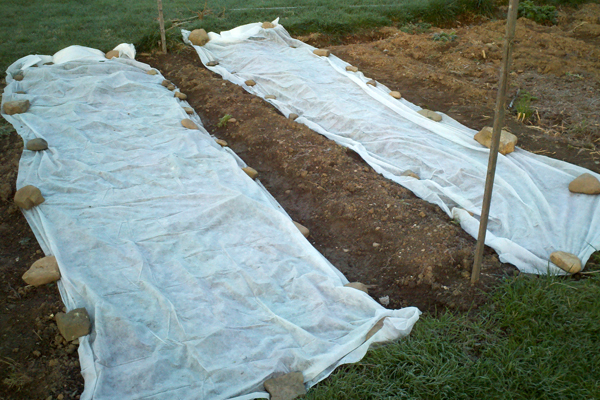Community /
Blogs
The opinions expressed in these blogs are solely those of the people who wrote them, and do not represent the views of WPSU or Penn State University.
Local Food Journey
Planting Cold-Hardy Veggies for Spring Crops
Posted by Jamie Oberdick on 04/05 at 02:17 PM

Floating row covers trap heat to protect from frost but allow light and water to reach plants. Photo Credit Jamie Oberdick.
As you probably noticed, the weather in mid-March was more along the lines of early June. This caused some absolutely incredible early spring scenes as spring growth is about a month ahead of schedule—blossoming trees, daffodils in full display, and perennials peaking out of the dirt at a much earlier date than normal.
For us gardeners, it was so tempting to get out there and plant something. So I did. I planted several rows in my garden, knowing full well that they would need protection later from the inevitable cold snap. If you still haven’t planted, no worries—you still have lots of time to plant cold-hardy vegetables in your garden.
First off, what are cold-hardy vegetables? Basically, any vegetable plant that can tolerate frost. So, you can plant them before the last frost date for your area, which can be found on this map. Mustard greens, spinach, Asian cabbage, swiss chard, and lettuce are a few examples.
It’s a good idea to plan what you are expecting to plant. This includes going through the seeds that you bought and researching planting dates. Some of the more cold-hardy plants like mustards, spinach, and peas need to be planted pretty early. Others like certain lettuces are less cold-hardy and need to be planted closer to your local last frost date.
You also need to find out how to plant them. Varieties often have different seed planting depths—something you need to pay attention to before heading out to the garden. Also, there are some types of cold-hardy vegetables that need to be started inside up to two months before the last frost date.
Once planted, you still need to monitor weather forecasts to keep an eye out for very cold temperatures. Temperatures well down into the 20s are going to require covering your plants. One solution is the floating row cover. It doesn’t, well, float in the air, but it is lightweight enough to cover your plants and still allow light and rain to get to them. The cover traps heat from the day and releases it at night. Another bonus is the cover keeps insect pests off your plants.
These plants really do need cool weather. If you get a sudden early season heat wave, some greens will “bolt,†or produce a flower stalk. At that point, they become bitter and inedible.
Of course, there’s also harvesting vegetables in spring, as opposed to waiting until summer.
![]() Author: Jamie Oberdick
Author: Jamie Oberdick
Bio: Editor, Local Food Journey | Passionate about supporting local food in Central PA
Leave a Comment
Commenting is not available in this section entry. « Mushroom Recipe Contest and Shiitake Mushroom Bisque from Chef Harrison Local Artist Profile: Maura Westerlund »Most recent entries
 Our Local Food Journey comes to an end
Our Local Food Journey comes to an end- Wednesday, January 31, 2018
- By Jamie Oberdick in Local Food Journey
 Winter isn’t a quiet time at the farm
Winter isn’t a quiet time at the farm- Wednesday, January 31, 2018
- By James Eisenstein in Local Food Journey
 Get the taste of garden season right now by growing herbs indoors
Get the taste of garden season right now by growing herbs indoors- Friday, January 26, 2018
- By Jamie Oberdick in Local Food Journey
 All you need to know about PASA’s Farming for the Future conference
All you need to know about PASA’s Farming for the Future conference- Friday, January 19, 2018
- By Jamie Oberdick in Local Food Journey
Categories
Archives
- January 2018
- December 2017
- November 2017
- October 2017
- September 2017
- August 2017
- July 2017
- June 2017
- May 2017
- April 2017
- March 2017
- February 2017
- January 2017
- December 2016
- November 2016
- October 2016
- September 2016
- August 2016
- July 2016
- June 2016
- May 2016
- April 2016
- March 2016
- February 2016
- January 2016
- December 2015
- November 2015
- October 2015
- September 2015
- August 2015
- July 2015
- June 2015
- May 2015
- April 2015
- March 2015
- February 2015
- January 2015
- December 2014
- November 2014
- October 2014
- September 2014
- August 2014
- July 2014
- June 2014
- May 2014
- April 2014
- March 2014
- February 2014
- January 2014
- December 2013
- November 2013
- October 2013
- September 2013
- August 2013
- July 2013
- June 2013
- May 2013
- April 2013
- March 2013
- February 2013
- January 2013
- December 2012
- November 2012
- October 2012
- September 2012
- August 2012
- July 2012
- June 2012
- May 2012
- April 2012
- March 2012
- February 2012
- January 2012
- December 2011
- November 2011
- October 2011
- September 2011
- August 2011
- July 2011
- June 2011
- May 2011
- April 2011
- March 2011
- February 2011
- January 2011
- December 2010
- November 2010
- October 2010
- September 2010
- August 2010
- July 2010
- June 2010
- May 2010
- April 2010
- March 2010
- February 2010
- January 2010
- December 2009
- November 2009
- October 2009
- September 2009
- August 2009
- July 2009
- June 2009
- May 2009
- April 2009
- March 2009
- February 2009

NO COMMENTS